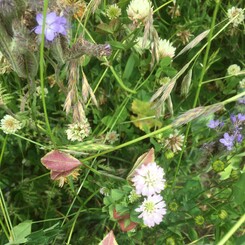Persian Clover
Trifolium resupinatum
An erect, annual legume used for sheep grazing, hay or silage production, providing high-quality feed from late winter to early summer. Reasonably new to New Zealand. Grows to 50 cm and has flattish looking white to light pink flowers at the top of its stem. If the flowers and seed heads are consumed by stock seed setting can be a problem under grazing. Most cultivars are soft-seeded, meaning seeds can germinate over the summer, which is not ideal for the regeneration of the pasture. Requires P and K fertiliser to encourage early root development and seedling vigour.
pros
Palatable with high soluble carbohydrate and high protein content
Appetising and nutritious forage during winter, spring & summer
Recovers well from grazing if not wanting for seed production
High nutritive value.
High DM production in spring
Is a self-seeding annual
Grows when rainfall is below 500 mm
Tolerant of wet soils, frost and cold but slow-growing at low temperatures
Thrives in a wide range of soils where other clovers struggle,
Very tolerant of poorly drained waterlogged soils
PH 6 or above
No estrogen risks
cons
May produce photosensitization in stock if fed as a mono-crop
Not bloat safe
Very palatable to insects, slugs and grazing pests like ducks, geese and rabbits
Sow no deeper than 4-5 mm
Susceptible to weed and grass competition as an establishing crop
Reduced winter dry matter production
need to restrict grazing during flowering if reseeding is required
Generally requires annual re-sowing under New Zealand management systems
Very poor regeneration as most cultivars available in New Zealand have no hard seeds so are unlikely to re-establish successfully because seeds often germinate after summer rains; this is the wrong time of the year for the successful establishment
Do not spring sow Persian it will not establish successfully and needs to be sown in autumn as soon as there is adequate soil moisture
Susceptible to glyphosate and other many broad-leaf herbicides
Sowing.
Sow at 5-6 kg/ha for a single species grazing or hay crop
Using higher seeding rates will increase yields and suppress weeds better.


